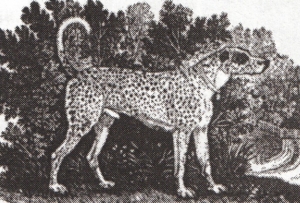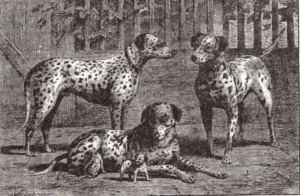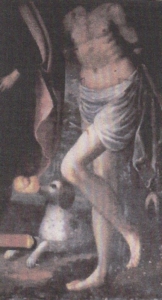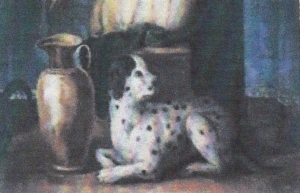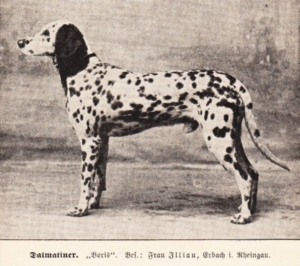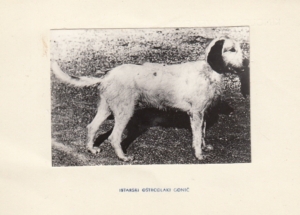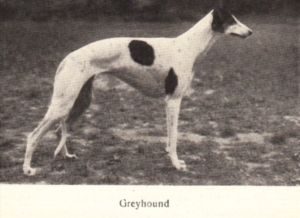Origin of the Dalmatian – History
In 1890, the first breed standard for the Dalmatian was established in England, and in 1955, the Dalmatian was officially recognized by the FCI (Fédération Cynologique Internationale). Subsequently, possibly in 1987, the Dalmatian was classified by the FCI in Group IX, Sociable and Companion Dogs. The reasons for this decision are no longer traceable today, and Group IX did not do justice to the Dalmatian in any case. Since the mid-90s, it has belonged to Group VI, Scenthounds and Related Breeds, without a working trial.
The origin of the Dalmatian.
Regardless of the dog breed being discussed, it is often challenging to provide precise information about the history and development of the breed. For many breeds, we only have limited knowledge of when and where they originated and their true ancestral roots.
The Dalmatian, with its beauty, is among those breeds recognized worldwide by all dog enthusiasts and children, even though its exact origin remains unknown. Regardless of many other questions, it is clear today that Dalmatians bear the right name, derived from the region in the present Republic of Croatia, the land of Dalmatia.
Dalmatians belong to FCI Group VI, and they should remain in this group. Many historical documents support this, especially recent biochemical and genetic research results.
As early as 1353, an unknown Dutch travel writer mentioned seeing dogs with white fur and black spots in Dalmatia.
Evidence of the widespread presence of Dalmatians outside Croatia can be found in symbols from the Serbian Orthodox monastery in Kosovo, Gračanica, built in 1315. An icon from the mid-16th century in this monastery depicts a spotted dog, a Dalmatian.
In the same century, in 1567, the Italian zoologist Ulisse Aldrovandi wrote “De quaropedibus Digitalis viviparis,” stating the existence of white hounds with small markings and black spots on their backs in Italy. He called these dogs “Canis sagax Vulco Brachus” and explained that they were brought to Italy from the (then) Italian provinces of Istria and Dalmatia over the Apennines.
The English author Edward Tops confirmed Aldrovandi’s statement in 1607 in his book “The Historie of Four footed Baestes,” suggesting that the spotted white and brown dogs found in Italy should be better referred to as Bracken.
The Flemish painter Pieter Boel (1622-1674) depicted a hunting dog with slain birds, specifically a Dalmatian with a black spot on its ears and tricolor markings.
One of the most significant original documents about the Dalmatian is the manuscript “De vita populi et de cultura armentorum et pecorum Diaco et eius anno Domini 1719 Districtus,” written by Bishop Petar Bakić. He writes about the “Canis Dalmaticus” originating from Croatia, Dalmatia, describing the dog as white with black spots and emphasizing its role as a hunting dog.
The work “The History of Quadrupeds” by the English zoologist Thomas Bewick in 1792 is noteworthy, stating that this is not a “Bengal Brach” but the Dalmatian or Coach Dog.
In the left illustration, there is a Dalmatian with black ears and a monocle around the eye.
In 1867, Leopold Josef Fitzinger described a Dalmatian called “Dalmatinischer Vorstehhund” (Dalmatian Pointing Dog or Canis gallicus Ragusanus) and referred to it as the “Dubrovnik Pointing Dog.” However, at this time, the distinction between pointing dogs and hounds was still very slight.
Ludwig Beckmann published an article in 1895 about Dalmatians, portraying the dog as a symbol of luxury. In the picture, three adult dogs and two puppies are visible, all with black ears.
The oldest painting in Dalmatia depicting a Dalmatian was discovered in 1996 by Dipl.-Ing. Boris Spoljaric. It is located in the “Our Lady of the Angels” church on the island of Veli Lošinj, built in 1566. Unfortunately, the artist is not known, but the painting dates back to the 17th century. (Photo: B. Špoljarić)
In the Mary Monastery of the Franciscans in Zaostrog (Makarska), there is a painting titled “The Last Supper.” The painting, dating back to the year 1750, features a Dalmatian in one corner. (Photo: B. Špoljarić)
In the book “Grundlehren der Hundezucht” (Fundamentals of Dog Breeding) by Dr. phil. A. Strösse, published in 1897, there is a drawing of a Dalmatian with brown ears.
Similarly, in the book “Gebrauchs- und Luxushunde” (Working and Luxury Dogs) written by Emil Ilgner in 1902, there is a description of the Dalmatian and a photo of a Dalmatian with clearly black ears.
The Dalmatian is classified among the hounds, and it is a true hound. Additionally, the Dalmatian is closely related to the Istrian Hound and the large English Greyhound, the Greyhound!
Research conducted at the University of Veterinary Medicine in Zagreb (1991, 1992) revealed a significant similarity in physiological values of uric acid between the Istrian Hound and the Dalmatian.
Black ears and black spots on the body in the Rough-haired Istrian Hound (Archive M. Urošević).
Furthermore, there is a strong genetic correlation in the color formulas. For the Dalmatian, the formula is BB CC DD EE gg swsw TT (Willis, 1984), while for the Istrian Hound, the genetic color code is: bb CC dd ee gg swsw TT.
Therefore, there is only a difference in specific factors. The color codes in the Dalmatian occur predominantly in a homozygous state, while in the Istrian… (the text appears to be incomplete; please provide the continuation if necessary).
Unlike these similarities, there is a close connection between the Dalmatian, Istrian Hound, and the Greyhound! The analysis of mitochondria (DNA) shows a close relationship among these breeds (Zajc, Kus, 2001).
This raises a question that remains open: when did the separation of these breeds occur? It is challenging to determine, but it is likely around the time of the Celts.
Copyright: Dr.sci.Dr.Vet.Med. Milivoje Urošević (www.milivojeurosevic.com)
Aside from numerous books and scientific publications (see the homepage, link to www.milivojeurosevic.com), Dr. Milivoje Urošević has published the following breed-specific Dalmatian articles:
1. Urošević M.: (1980.) Dalmatinci svijeta ujedinite se. Moj pas, br. 9 – 10, Zagreb
Urošević. M: (1980) Dalmatiner in der Welt vereinigen sich. Moj Pas. 9 – 10, Zagreb
2. Urošević,M. (1984.) Nasledne mane kod dalmatinskog psa. 4.Jugoslovenski simpozijum „Male životinje i urbana sredina“, Ljubljana.Zbornik referata, str. 59-62
Urosevic, M. (1984) Vererbte defekte bei Dalmatiner. 4.Jugoslovenski Symposium “Kleintiere in städtischen Gebieten” Ljubljana.Zbornik Papier, p. 59-62
3. Urošević,M.: (1984.) Uzgoj dalmatinskog psa u Jugoslaviji, sa posebnim osvrtom na SR Srbiju i Beograd, u periodu od 1948-1982. 4. Jugoslovenski simpozijum „Male životinje i urbana sredina“, Ljubljana. Zbornik referata, str. 63-67
Urošević. M: (1984) Dalmatiner Zucht in Jugoslawien, mit besonderem Schwerpunkt auf SR Serbien und Belgrad, in der Zeit von 1948 bis 1982. 4. Symposium “Kleine Tiere in der städtischen Umwelt”, Ljubljana. Proceedings, S.. 63-67
4. Urošević M.: (1987.) Biometrijski parametri dalmatinskog psa. 5. Jugoslovenski simpozijum „Male životinje i čovek u zajedničkom ambijentu „. Beograd. Zbornik radova,str.219-221
Urošević. M: (1987) Biometrische Parameter bei Dalmatiner. 5. Symposium “Kleine Tiere und Menschen in der gleichen Umgebung.” Belgrad. Proceedings, str.219- 221
5. Urošević M., Fury M.: (1987.) Plodnost dalmatinskog psa. 5. Jugoslovenski simpozijum „Male životinje i čovek u zajedničkom ambijentu“. Beograd. Zbornik radova,str.222-224
M. Urosevic, M:. Fury (1987) Fertilität bei Dalmatinär. 5. Symposium “Kleine Tiere und Menschen in der gleichen Umgebung.” Belgrad. Proceedings, str.222-224
